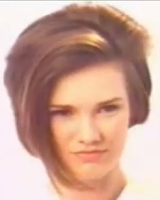If you are considering having your hair colored in any way, I suggest you read this article has to say beforehand, so that you at least know what you're getting yourself into.
The 3 C's Principle: Color Comes at a Cost
Color isn't cheap. In fact, it's pretty expensive if you do the math. At a decent salon, partial highlights can cost $85! At very upscale salons that I have worked at in the past, partial highlights have cost even more than that! One should also remember that even though many haircuts grow out well, color does not follow the same trend. This means you'll likely be taking a trip to the salon for a color touch up once per month. Over the course of a year, that adds up to... hold your breath for this one... over $1,000. To me (as I personally have no color in my hair), that is an outrageous amount of money to be spending on one's hair.
Turning Back Isn't Easy....
So let's pretend for a moment. Let's say that during a recent trip to the salon, at your stylists prodding, you have decided you wanted to color partially highlight your hair, or even color your hair fully. In about four weeks, you'll begin to see a substantial bit of regrowth at the roots (which of course does not match the color of your highlights/new haircolor). You will then (presumably) go to the salon and have your color touched up, as if you didn't, your hair would look fairly awful. This process then repeats itself for sometime. Then one day, before your next touch-up, you notice that the color of your highlights has changed a bit from the color that they were just after your last touch up. During your next touch up, you ask the stylist about this. She/he responds "Well, that's actually fairly normal, as the color does tend to yellow a bit over time." You've now come to the realization that all the money that you have been spending on in-salon haircolor has really only bought you a nice looking head of hair for about a week after you leave the salon, leaving the other 3+ weeks to yellowing color and regrowth. So now you've had enough of this money pit you say? Well you have a few options at this point. You can: wait untill there is quite a bit of regrowth (2-3 inches worth) then cut your hair short, wait untill regrowth eventually overcomes the current haircolor (takes time, several months chin length hair), or dye your hair back to it's natural color. The third option seems like the best out of the three, however that does not necessarily make it a good one. IF YOU ARE VERY LUCKY: your stylist will be able to dye your hair back to natural base on the first try (this costs money). IF YOU ARE VERY UNLUCKY: it will take multiple attempts, quite possibly multiple salons, a lot of dissatisfaction, and wait for it... tons more money, to once again achieve natural base color.
In Review:
- Haircolor is a money pit.
- Haircolor requires extensive upkeep, maintenance, and investment.
- Once you have haircolor and are in the money pit, you will find that such a money pit has very high walls and is extremely hard to get out of.


















